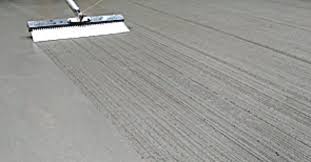What are the Different Types of Concrete Finishes?
No, it is not true that concrete takes 100 years to cure, but it can last for just as long! The construction material contains the right amounts of cement, fine and coarse aggregate, and water. In its green form, you can mold concrete into any size, shape, and finish using different finishing techniques to add aesthetic value to a surface.
Upgrading your flooring with a concrete finish is an excellent way to add durability and style to garages, patios, utility areas, basements, and landscaping. Modern industrial design trends are behind some of the most creative ways of using concrete finishes for functional and decorative objectives.
Here is more information about the different types of concrete finishes, their uses, and their benefits.
Troweled
The flooring finish requires smoothing out the top layer of cast concrete using a trowel. Workers use the flat bottom to flatten the concrete for a smooth finish or a distinct look. Trowels can also create an arch or swirl pattern before the concrete dries.
A trowel with a coarse texture can help make a more noticeable swirl design on the floor. Smooth-surface trowels are the best option for a minimalist design.
Uses: A popular finish for walls, indoor spaces, utility areas, roof slabs, commercial spaces, and garages.
Benefits:
- A clean and sleek appearance for complementing minimalist and contemporary designs
- Troweled surfaces can have a lustrous and glossy appearance to brighten interior spaces
- Easy to clean
- Durable and resistant to wear, abrasion, and heavy use
Broom
Also known as brushed concrete, this finish type uses a broom to improve the slip resistance of concrete. The process creates small bumps on the surface, giving it an uneven texture that looks more hand-brushed. Using different sizes of broom bristles will help alter the width and depth of the ridges.
Uses: The broom finish works for outdoor spaces like walkways, swimming pools, driveways, patios, and parks.
Benefits
- The textured grooves are slip-resistant, even with water on them
- A cost-effective finish that requires minimal labor and tools
- Easy application
- Durable against heavy foot traffic and wear
Stamped Concrete
Stamped concrete features an ornamental finish that resembles other materials, including granite, wood, slate, bricks, or tiles. The process involves pressing your desired patterns on a freshly leveled concrete surface. Adding color can help enhance the effect you are going for.
Uses: A stamped concrete finish works well in outdoor spaces such as walkways, patios, landscaping, and recreational areas.
Benefits:
- Available in various design options for maximum personalization
- Less expensive than stone, bricks, and slate while still mimicking them
- A durable surface for high-traffic areas
- The only maintenance required is the occasional cleaning and resealing
Exposed Aggregate
Aggregate finishing involves using minute particles to cover the cement’s surface. The new concrete surface is first washed off to uncover pebbles, stones, or other materials in the mix. Contractors will use different acid wash methods to accomplish the effect.
After washing, professionals use special coatings or sealers to protect flooring from weathering.
Uses: An exposed aggregate finish is advisable for outdoor spaces such as patios, driveways, and parks.
Benefits:
- Using different materials as aggregates brings out a distinct aesthetic interest in decorative spaces
- A slip-resistant finish for areas with moisture
- Durable for high-traffic areas
- Exposed aggregates help hide tiny flaws, stains, and dirt to make the floor easy to maintain
Colored
A colored concrete finish is achieved using pigments or through post-cure staining to create a look that matches the surrounding environment. Workers add color pigments directly to the concrete mix before pouring. Post-cure staining involves applying stains to concrete of any age for a vibrant finish.
Uses: A colored finish is a fantastic idea for outdoor and indoor spaces, industrial buildings, commercial facilities, and recreational spaces.
Benefits:
- A wide range of colors is available
- The colors are resistant to UV damage
- It’s easy to customize your color intensity
- Minimal maintenance required
Polished
Mechanical grinding and polishing processes help create a polished finish on a concrete surface. Flooring professionals use penetrant chemicals with specialized tools to achieve different surface textures.
Uses: Choose a polished concrete finish for your indoor spaces in a home, office building, showroom, retail store, or large warehouse.
Benefits:
- A clean and elegant appearance that helps bring a high-end touch to your space
- Resistant to wear, chipping, and flaking
- Easy to clean with little sweeping and mopping
- Durable
Salt
The salt finish technique involves applying course rock salt crystals to a wet cement surface. Contractors will use a brush, stencil, or even their hands to apply the crystals.
Uses: A salt concrete finish works well in areas around moisture, such as large fountains and pool decks.
Benefits:
- The fine-textured and mottled appearance gives the floor an attractive weathered or stone-like effect
- Slip-resistant
- A cost-effective solution
- Durable because it can hide minor imperfections well
Start Your Project
Finishing a concrete floor is critical for creating a durable and beautiful surface. However, make sure you get in touch with professionals to ensure you get the results you desire. These flooring experts have the tools that make achieving a professional finish on any concrete surface faster and easier.



